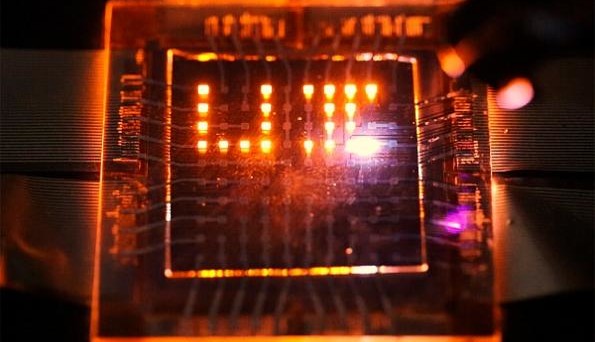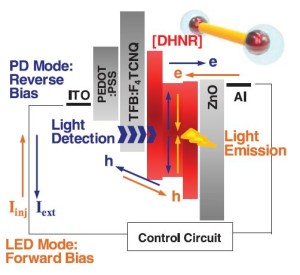World First: 80,000 cd/m2 LED detects light too
February 14, 2017
on
on

Working together on what may become a groundbreaking technological advancement, researchers from the US and South Korea have reported a novel type of nanoLEDs capable of operating both as a light emitter and a light detector. The researchers hope and expect the dual-mode LEDs to enable new types of interactive displays.
The double-heterojunction nanorod (DHNR) light-responsive LEDs are about 50 nm long and 6 nm in diameter. They include quantum dots of two different types, one of which can enhance radiative recombinations (useful for LEDs) while the other type leads to efficient separation of photo-generated carriers.
The layered structures in these anisotropic nanorods can be tuned independently so as to fine-tune both recombination and charge separation in a single device, hence enabling a single nanorod to be electroluminescent and generate a photocurrent. Once appropriately stacked between electrodes, the nanorods can be arranged into pixels that can be switched between light-emitting and light-detecting modes by simply changing a voltage bias (forward or reverse).
The “LEDetector” (my word coinage, Ed.) has a turn-on voltage of just 1.7 V, achieves whopping brightness levels in excess of 80,000 cd/m2, and also exhibits low bias and high efficiencies at display-relevant brightness. The research team reports an external quantum efficiency of 8.0% at 1000 cd/m2 under 2.5 V bias.
 In one experiment a 10×10 pixel DHNR-LED array was operated (under reverse bias) as a live photodetector, combined with a circuit board that supplied a forward bias to any pixel detecting incident light. By alternating forward and reverse bias at a sub-millisecond time scale, light-detecting pixels could be “read out” as they illuminated the array.
In one experiment a 10×10 pixel DHNR-LED array was operated (under reverse bias) as a live photodetector, combined with a circuit board that supplied a forward bias to any pixel detecting incident light. By alternating forward and reverse bias at a sub-millisecond time scale, light-detecting pixels could be “read out” as they illuminated the array.
Future applications, your ask?
The fact that patent applications for this technology exist with co-authors from Dow Chemical shows there is commercial interest.
The findings are published in Science in a paper titled "Double-heterojunction nanorod light-responsive LEDs for display applications"
The double-heterojunction nanorod (DHNR) light-responsive LEDs are about 50 nm long and 6 nm in diameter. They include quantum dots of two different types, one of which can enhance radiative recombinations (useful for LEDs) while the other type leads to efficient separation of photo-generated carriers.
The layered structures in these anisotropic nanorods can be tuned independently so as to fine-tune both recombination and charge separation in a single device, hence enabling a single nanorod to be electroluminescent and generate a photocurrent. Once appropriately stacked between electrodes, the nanorods can be arranged into pixels that can be switched between light-emitting and light-detecting modes by simply changing a voltage bias (forward or reverse).
The “LEDetector” (my word coinage, Ed.) has a turn-on voltage of just 1.7 V, achieves whopping brightness levels in excess of 80,000 cd/m2, and also exhibits low bias and high efficiencies at display-relevant brightness. The research team reports an external quantum efficiency of 8.0% at 1000 cd/m2 under 2.5 V bias.
 In one experiment a 10×10 pixel DHNR-LED array was operated (under reverse bias) as a live photodetector, combined with a circuit board that supplied a forward bias to any pixel detecting incident light. By alternating forward and reverse bias at a sub-millisecond time scale, light-detecting pixels could be “read out” as they illuminated the array.
In one experiment a 10×10 pixel DHNR-LED array was operated (under reverse bias) as a live photodetector, combined with a circuit board that supplied a forward bias to any pixel detecting incident light. By alternating forward and reverse bias at a sub-millisecond time scale, light-detecting pixels could be “read out” as they illuminated the array.Future applications, your ask?
- translate any detected signal into brightness adjustments;
- automatic brightness adjustment in response to external light–intensity change;
- direct imaging or scanning at screen level;
- display-to-display data communication.
- Displays can harvest or scavenge energy from ambient light sources without the need for integrating separate solar cells.
The fact that patent applications for this technology exist with co-authors from Dow Chemical shows there is commercial interest.
The findings are published in Science in a paper titled "Double-heterojunction nanorod light-responsive LEDs for display applications"
Read full article
Hide full article


Discussion (3 comments)